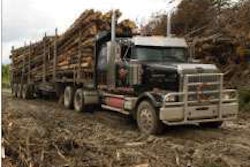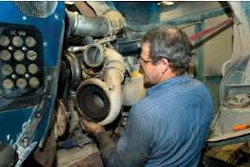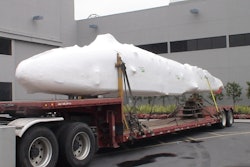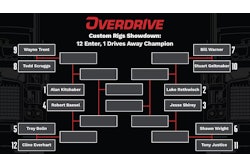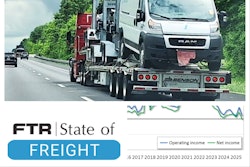Getting on board
Some owner-operators fear that electronic onboard recorders cost too much and invade their privacy. As EOBR use spreads, others are embracing them after discovering improved productivity, safety and record-keeping.
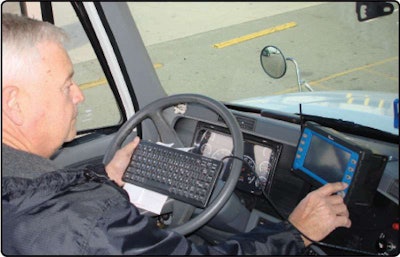 PeopleNet’s onboard recorder uses cellular communications and offers features beyond electronic logging.
PeopleNet’s onboard recorder uses cellular communications and offers features beyond electronic logging.By Todd Dills
Prime driver Gene St. Germaine, of Candler, N.C., was among the first of the fleet’s drivers and leased owner-operators to transition late last year to electronic onboard recorders. He calls the technology a deterrent to being a “supertrucker” driving beyond legal and physical limitations, “just a bullet flying down the road waiting to hit something.”
While paper logs could be manipulated, “you can’t fudge this,” he says. The EOBR “tells you when you only have another hour before you go into DOT violation. Every fifteen minutes that go by, it keeps telling you, ‘You’ve got to shut down.’ That’s a great safety feature.”
St. Germaine is hardly alone in his opinion. Many large carriers have been using EOBRs for months, even years, and are getting positive reports from drivers and management. With that momentum, a new federal rule mandating their use for unsafe carriers, and new motivation for using EOBRs linked to the onset of the Comprehensive Safety Analysis 2010 program, it appears electronic logging will continue to spread much further.

Even though it will be 2012 before the newly issued EOBR rule from the Federal Motor Carrier Safety Administration takes effect, thousands of EOBRs are in use. PeopleNet eLogs Product Manager Jim Angel says that eLogs since 2003 has been installed in upwards of 100,000 power units, mostly in private fleets. Qualcomm units are also in thousands of trucks.
Qualcomm reps noted greater prevalence of use in private fleets, adding that the pace of adoption among for-hire carriers is accelerating. Among those, Werner Transportation has been running electronic for years. Carriers recently adopting or testing EOBRs include FedEx Custom Critical, Schneider National, Prime Inc., Marten Transport, Central Refrigerated, May Trucking and TCW.
EOBR benefits
Since February, Bob and Linda Caffee, team expediters leased to a major carrier, have used the Qualcomm MCP200 unit in their Freightliner Business Class M2. “We know several people who were dead set against [EOBRs], who now say they’ll never go back to paper logs,” Bob says.
 Schneider National, the nation’s largest truckload carrier, uses the Qualcomm MC200 for electronic logging and other purposes.
Schneider National, the nation’s largest truckload carrier, uses the Qualcomm MC200 for electronic logging and other purposes.That’s what former FMCSA Administrator John Hill, now a consultant, often hears at speaking engagements. “There have been at least five instances where people came up to me after the presentation,” he says. “What they said was, ‘We were a carrier and … got into trouble with the hours of service and worked with FMCSA to get EOBRs put in, and the drivers, including the independent contractors, thoroughly enjoyed it and they wouldn’t go back. It creates an atmosphere where everybody in the organization knows that this is how we will do business, and it removes the idea that there’s any possibility of cheating.’”
With current EOBRs, users can benefit from functions beyond logging driving hours. Schneider National, FedEx Custom Critical and many other carriers have adopted Qualcomm’s MCP200, which offers the operator a sophisticated touch-screen display and text-to-voice capabilities to navigate functions such as GPS-enabled driving directions, communications, wireless Internet access and electronic logs. In this and some other systems, one touch of a button displays your location on a screen.
 “I don’t want Big Brother telling me what I can and can’t do. That’s why I became an independent operator: to be my own boss.” — Independent Howard Salmon, about his resistance to electronic logging.
“I don’t want Big Brother telling me what I can and can’t do. That’s why I became an independent operator: to be my own boss.” — Independent Howard Salmon, about his resistance to electronic logging.Marten Transport, which moved to electronic logs last year, is also implementing the MCP200. The decision, says company Information Systems Director Randy Baier, “was independent of the onboard logging decision – the other capabilities drove it,” including the fact that communications are conducted through the cellular network rather than via satellite.
The PeopleNet system, also utilizing cellular communications, includes automated fuel tax possibilities, Angel says. “The system captures fuel mileage info, a lot of stuff that makes life simpler for a single driver or a fleet of drivers.” For example, you can communicate with shippers to notify them of exact delivery times for dock prep.
An EOBR can provide data on idling and hard braking, says Dave Osiecki, senior vice president for regulatory affairs for the American Trucking Associations. “Even if you are a two- or three-truck fleet – if you turn them on and use that data, there’s value to be had. The [return on investment] can be found. The intangibles – the hassle of filing paper, filing logs – still apply to a small carrier as well.”
 “It’s compact, easy and quick to operate. It has a touch screen and a drop-down keyboard. If I’m pulling into a truck stop to fuel, I just use the touch screen and flag it ‘fueling.’” — Schneider owner-operator Sam Mobley about the Qualcomm MCP200 he uses for electronic logging
“It’s compact, easy and quick to operate. It has a touch screen and a drop-down keyboard. If I’m pulling into a truck stop to fuel, I just use the touch screen and flag it ‘fueling.’” — Schneider owner-operator Sam Mobley about the Qualcomm MCP200 he uses for electronic loggingMany of these capabilities, however, are achievable with applications on GPS-enabled smartphones or laptops, including logging. To be truly electronic in terms of the regulations, though, an EOBR synchronized with the truck’s electronic control module is the sole solution. At least one EOBR solution uses smartphones for regulations-compliant electronic logging. The system is much cheaper than other leading EOBRs. As technology and competition advances, prices could drop further.
Charlotte, N.C.-based owner-operator Sam Mobley, Overdrive’s Trucker of the Month in August 2007, began testing electronic logs in his fleet, Schneider, in February 2009. He’s been officially logging electronically with the MCP200 since November.
“I tried to find every reason in the world not to like these things – and to not make it work – as I could,” he says. “There’s a learning curve at the beginning. I told myself, ‘I can do it faster with pencil and paper.’ But you get in a routine of what you do with it. And I thought I’d never say it, but I do not want to see another paper log book.”
EOBR opposition
Many owner-operators, as well as the Owner-Operator Independent Drivers Association, have long opposed EOBRs. A primary concern is that they amount to Big Brother invading the privacy of your cab and controlling your hours and miles.
“I answer to myself and my wife in questions about my company,” says Howard Salmon, who runs under his own authority and was Overdrive’s Trucker of the Month for October 2009. “I don’t need anybody trying to tell me how to drive.”
Also, not everyone buys the assumption that EOBR use improves safety. “You can put an EOBR in every truck in the United States,” says OOIDA Regulatory Affairs Specialist Joe Rajkovacz, “but you’ll still have the same crash statistics.” The “only way the agency will come up with an across-the-board mandate” is by linking EOBR use with crash risk reduction, “which they haven’t,” he contends.
The Commercial Vehicle Safety Alliance, after the 2007 proposed EOBR rulemaking, cited similar concerns, as have other organizations. But groups such as Public Citizen use studies analyzing safety outcomes in Europe, where similar technology has been used since the 1970s, to back up their claims that an EOBR represents a clear safety benefit by reducing the amount of cheating on logs.
 Stephen Adams, driver for Oregon-based May Trucking and writer behind the trucking commentary blog TruckerSteve.org, says his electronic logging saves three to four hours in paperwork over a 70-hour period. With the EOBR, he’s averaged 3,200 weekly miles. Other productivity gains associated with newer EOBRs include faster determination of logging location, GPS navigational features and, for independents, elimination or reduction of filing duties related to printed logs, fuel-tax reporting and quarterly estimated tax preparation.
Stephen Adams, driver for Oregon-based May Trucking and writer behind the trucking commentary blog TruckerSteve.org, says his electronic logging saves three to four hours in paperwork over a 70-hour period. With the EOBR, he’s averaged 3,200 weekly miles. Other productivity gains associated with newer EOBRs include faster determination of logging location, GPS navigational features and, for independents, elimination or reduction of filing duties related to printed logs, fuel-tax reporting and quarterly estimated tax preparation.Another objection to required use, Rajkovacz points out, is that the costs cannot be justified. He estimates up-front costs of $1,000 to $3,000 per unit, plus a monthly service fee.
PeopleNet’s Angel counters that a single-truck owner-operator could get into the company’s basic system “with a $900 to $1,100 investment, then a $45 monthly fee” for cellular service.
At Prime, says Safety Director Don Lacy, leased owner-operators not in the company lease-purchase program were assessed minor charges for changing certain cables but not the cost of the units themselves nor the monthly service fee. Schneider National’s approach to installation of the new MCP200 units reflects that of many large fleets with mandatory communications modules – no chargebacks to owner-operators for installation or use. Owner-operators are more likely to face some charges if the installation is not mandatory.
Owner-operators with particular smartphones already in-cab, depending on the phone type, may own EOBR-capable equipment already. Contrary to many claims, there are inexpensive and compliant devices on the market today. In reviewing the costs and benefits of its new EOBR rule, FMCSA said that the least expensive device it found that satisfied agency requirements was the RouteTracker, which is sold by Xata Turnpike, a division of Xata Corp. Like Qualcomm and PeopleNet, Xata also sells more comprehensive fleet management systems.
RouteTracker features a small GPS device wired to the engine’s electronics, as required to qualify as an EOBR. If an owner-operator already had a Java-enabled handheld device – generally a smartphone of some type – he would sync it with RouteTracker and run software that would access driver logs. Log history would be accessible via an online storage account. The cost for the ECM-connected device, software and sufficient data storage to meet FMCSA’s requirements is $35 to $50 a month, with a $25 activation fee, Xata says.
CSA impact
The approach of CSA 2010, now delayed to Nov. 30 and with full implementation delayed until mid-2011, could cause the EOBR to be perceived as a more positive tool, says PeopleNet’s Angel.
CSA 2010’s scoring methodology will incorporate far more data than is processed now under SafeStat and, if results from test states hold true for the nation, bring many more fleets and drivers to the attention of law enforcement. EOBRs’ ability to substantially reduce HOS violations could make the devices more attractive to smaller fleets, even independent owner-operators.
 “Rather than waiting for the regulatory people to put things on you, do it, get it in the truck, and now you can help them write the regulation. It’s better to work with them than against them, because it’s not a question of if, it’s when.” — Bob Caffee
“Rather than waiting for the regulatory people to put things on you, do it, get it in the truck, and now you can help them write the regulation. It’s better to work with them than against them, because it’s not a question of if, it’s when.” — Bob CaffeeWhen CSA 2010 is in place and FMCSA intervenes with carriers due to a deficiency in the fatigued driving category, carriers utilizing true EOBRs will have an immediate advantage in their peer group there, grouped as they will be by the number of relevant HOS-related inspections.
Angel, formerly a carrier for broker C.H. Robinson, notes that Robinson already collects Safestat scores from its carriers. Demand for that information could drive the use of EOBRs, says Angel.
“For violations written in 2009,” says Angel, “the top 10 violations represent 79 percent of the total violations. Of the top 10, five are driver-hours-of-service-related. Three of those five are related directly to regulation 395.8, which is the paper log environment: form and manner violations, duty status not current…. In an electronic environment, those three basically disappear.”
Angel further points out that of violations under CSA 2010, the paper-environment log violations range from two to 10 points, while the electronic violations are all one point. “Even if two carriers were given the same number of citations in either environment, it’s still two to one” in favor of the electronically logging carrier.
Intermodal carrier TCW started using PeopleNet’s eLogs system in the first quarter of 2008. “We’ve not seen a driver put out of service as a result of an hours-of-service violation in well over a year,” says Tim Smith, TCW safety director. That helps its current Safestat score, and with its early implementation of EOBRs, the carrier stands to have good scores in the Fatigued Driving category of CSA 2010.
St. Germaine says he’s already experienced some new leverage because shippers and receivers he encounters know he’s running electronic. On a pickup at a facility that prohibited truck parking, St. Germaine was out of hours after the shipper took four hours to load him. Understanding that St. Germaine was on electronic logs and any movement of the wheels beyond 0.7 miles would put him in violation, the shipper “made special arrangements for me to park in their back lot.”
Such responses could be just the tip of the iceberg as EOBRs become more common. “Shippers and receivers are going to discover that they have a clock, too,” says team expediter Linda Caffee.
Independents “will have to start taking a long, hard look at how they compare to some of the bigger carriers in CSA 2010,” says Angel. “If you’ve got a guy who’s aggressive enough to take on an EOBR, he might have a leg up” with brokers and shippers in the future.
Those who don’t get an EOBR voluntarily or through a carrier they’re leased to still are likely to have to adopt an electronic system eventually, some observers says. “Come three to five years from now,” ATA’s Osiecki says, “they’re likely to be mandated for everybody.” n
Rule will push recorders on thousands of carriers
By Avery Vise
Last month the Federal Motor Carrier Safety Administration announced a final rule for electronic onboard recorders that is significantly more stringent than a regulation proposed three years ago.
FMCSA now mandates EOBRs on carriers that are shown in a single compliance review to be in serious noncompliance with any major hours-of-service regulation. The final rule takes effect on June 4, 2012, giving EOBR suppliers time to adjust to the new performance standards adopted in the final rule.
 “I thought: Now I’ve got Big Brother watching me even closer. I won’t ever be able to sneeze again with him knowing. Once I learned its tricks and everything, I’d say it’s a lot better.” – Central Regrigerated driver Stephen Michaels on his carrier's move to electronic logs.
“I thought: Now I’ve got Big Brother watching me even closer. I won’t ever be able to sneeze again with him knowing. Once I learned its tricks and everything, I’d say it’s a lot better.” – Central Regrigerated driver Stephen Michaels on his carrier's move to electronic logs.In the regulation proposed in January 2007, the agency planned to mandate EOBRs based on a review of HOS records during each of two compliance reviews conducted within two years. FMCSA estimated that under the proposal, approximately 930 carriers would be subject to mandatory EOBRs. Those carriers had 90 percent higher crash rates than the general population.
Now FMCSA estimates nearly 5,700 carriers will use EOBRs after the final rule’s first year of implementation. Carriers that would be subject to mandatory EOBRs if the final rule were in place today have 40 percent higher crash rates than the general carrier population, FMCSA says.
Under the final rule, if an audit finds that a carrier has a violation rate of 10 percent or greater for any major HOS regulation contained in a new list, FMCSA will require the carrier to install EOBRs in all trucks and to use them for two years.
“We have no plans currently to challenge the EOBR rulemaking,” says Joe Rajkovacz, regulatory affairs specialist for the Owner-Operator Independent Drivers Association. “The rulemaking as it stands is eminently avoidable for motor carriers if drivers take care of their log books and make sure all date- and time-stamped documents (tolls, fuel receipts, etc.) match their logs.”
While the final rule, like the 2007 proposal, ties the EOBR mandate to remedial action, FMCSA elaborated in its new rule on plans for a broader rulemaking. It would expand the scope of mandatory EOBRs due to the safety risks of groups such as “passenger carriers, hazardous materials transporters, and new motor carriers seeking authority to conduct interstate operations.”
Under the performance standards of the new rule, EOBRs must automatically record the truck’s location at each change of duty status and at intervals while in motion. EOBRs also must conform to specific information processing standards to ensure data security and integrity.
FMCSA estimates the rule’s cost at $139 million a year and safety-related benefits at $182 million.
Todd Dills contributed to this report.
Other types of computer-assisted logging
One reason some carriers cite for using EOBRs is the 2008 Federal Motor Carrier Safety Administration determination it would begin considering electronic device position reports as supporting documents in hours-of-service compliance. In its April EOBR rulemaking, the agency offered fleets voluntarily installing EOBRs relief from driving time-related supporting documents requirements.
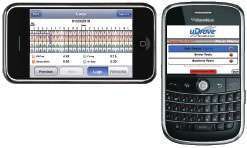 While not qualifying as an electronic onboard recorder under the federal definition, smartphone/web storage applications like uDrove (shown here on the iPhone and Blackberry) nevertheless are seeing increased use by owner-operators. The systems enable tax preparation, electronic documentation of logs and fuel purchases, and other paperwork-reducing tasks.
While not qualifying as an electronic onboard recorder under the federal definition, smartphone/web storage applications like uDrove (shown here on the iPhone and Blackberry) nevertheless are seeing increased use by owner-operators. The systems enable tax preparation, electronic documentation of logs and fuel purchases, and other paperwork-reducing tasks.Nydin Transport independent owner-operator Terry Angleton didn’t have that ruling in mind when he began cleaning up his Omaha, Neb., office this year, but he was worried about the possibility of an audit on his year-and-a-half-old business. He’s replacing paper documents with the uDrove service, a smartphone application installed on his Motorola HTC Eris, driven by the Android operating system. It’s combined with an online storage account for documentation of fuel purchases sorted by type (reefer or truck), mileage information tracked with GPS, load tracking information that can be shared with shippers and receivers, inspection reports and, yes, logs.
Companies offering similar logging applications – another is the laptop-based Driver’s Daily Log and a similar program for the iPhone – note they do not satisfy FMCSA regulations for EOBRs, but rather they’re lower-cost solutions that also save time. Considering the previously tedious preparation of quarterly estimated taxes alone, Angleton says, “now it’s all there in the database. That’s two to three weeks saved – $8,000-$10,000 saved a quarter.”
Daily information is stored online and can be faxed or e-mailed directly to an inspector, a process that drivers running with EOBRs say they’ve seen at inspection facilities, too. UDrove rep Katie Moser says that as DOT officers get used to electronic log displays, the regulatory necessity of being able to print your log is going by the wayside.
In a survey asking owner-operators what they wanted to do with their smartphones, she says, 33 percent said logging is most important.
One small step for truck, one giant leap for EOBR
Next time you see a truck rolling along the apron, stopping every half-mile, by all means fire up the CB to find out if the driver needs assistance. But don’t be surprised if it’s someone out of hours and trying to get to the next exit without triggering a violation via electronic log.
Contrary to road rumors, EOBRs aren’t foolproof. As with all technology, they’re dependent on their rigid systems as well as operator input to determine non-driving time. The “automatic” part of the logging process is all about movement – when the wheels roll, the systems commonly begin to log on-duty driving after 0.7 miles. Most systems use a preset time trigger, typically a few minutes, when the wheels stop moving and/or the engine shuts down, to move the driver to Line 4 – on duty, not driving – if he doesn’t give it input himself. (The new rule specifies a default setting of on duty, not driving after 5 minutes of no movement.)
Stephen Michaels, a driver for Central Refrigerated, says all non-driving time is editable on his Qualcomm unit. “If you stop, you’re on line 4. You can go back and edit it if you need to, but Line 3 – on duty, driving – you cannot edit that.”
Both Michaels and team expediters Bob and Linda Caffee have noted similar peculiarities of their systems that seem to be a function of GPS technology. “We drove to a military base,” Bob says of a particular pickup, “stopped and went on-duty, not driving. We had to go to another place, less than seven-tenths of a mile, then kept going back to the previous spot. In the end, it added up to three to four miles, but the system never logged us driving.”





